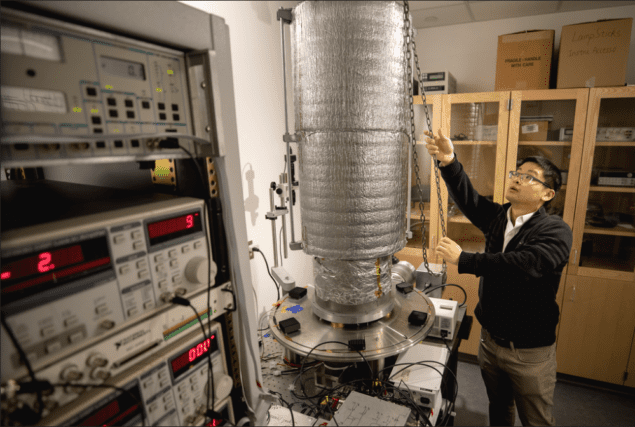
A new method for photonic cooling using light from a conventional LED has been demonstrated by researchers in the US. They achieved a modest cooling flux of about 6 Wm–2, but the scientists believe that future advances in nanophotonic surfaces could increase this by least two orders of magnitude – making the technique a promising candidate for cooling electronic devices.
In photonic cooling, a substance absorbs low-energy photons and then emits higher-energy photons – thereby losing energy. Success relies on the precision of a coherent single-frequency laser and attempting the same technique with a regular LED would fail because LEDs emit a wider range of frequencies. Instead, an LED would just heat the material.
In the last few years, however, scientists at Stanford University in the US, have theorized that normal LED light could be used to cool down matter. What is more, the cooling technique could someday rival widely-used thermoelectric devices. Now, Linxiao Zhu and colleagues at the University of Michigan have created such a cooling system that uses a normal LED.
Negative luminescence
The researchers made use of a phenomenon called “negative luminescence”. This occurs when an LED is connected to a reversed electrical bias, causing it to emit less thermal radiation than when under no bias at all. “In a sense”, says Michigan’s Pramod Reddy, “the reverse biased LED radiates photons as if at a much lower temperature”.
This effect on its own would normally lead to negligible cooling. However, such heat transfer can be greatly enhanced when the gap between the LED and the object to be cooled is shrunk to the nanoscale. In fact, recent research has shown that in this regime heat transport may significantly exceed the blackbody radiation limit. This increase is the result of photons that can “tunnel” from one object to another, explains Reddy.
Measuring this heat flow involved placing an LED at a nanoscale distance to a calorimeter, which was no easy task. According to Zhu, making the gap small enough would be impossible with a normal commercial LED, which has a surface roughness some 50-100 times larger than the required gap. Therefore, the team had to develop a custom approach for nanopolishing such devices.
Photonic tunnelling
The researchers performed their experiment in a high vacuum and ultra-low vibration chamber. When they decreased the distance between the LED and the measurement device down to 55 nm, they observed a huge jump in the calorimeter’s optical detection signal. It was at that point that the photonic tunnelling took effect. Then, having the diode’s bias oscillate between being zero and reversed, the team took a many-interval time-averaged measurement to accurately resolve the heat flux. What they found was that the calorimeter was indeed being cooled by the LED.
The team is adamant about taking this research further and exploring what the fundamental limits to this cooling approach are. The researchers are hoping that with a suitably engineered diode, they could approach the theoretically predicted cooling flux of about 1000 Wm-2. At such efficiency, Reddy claims, this novel approach would rival cooling technologies based on thermoelectric materials. In the future this method could find application in electronic devices, providing on-chip cooling.
Full results are published in Nature.



